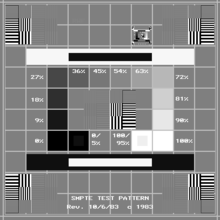Society of Motion Picture and Television Engineers
The Society of Motion Picture and Television Engineers (SMPTE (/ˈsɪmptiː/, rarely /ˈsʌmptiː/), founded in 1916 as the Society of Motion Picture Engineers or SMPE,[1] is an international professional association, based in the United States of America, of engineers working in the motion imaging industries. An internationally recognized standards organizations, SMPTE has more than 600 Standards, Recommended Practices and Engineering Guidelines for television production, filmmaking, digital cinema, audio recording, information technology, and medical imaging. In addition to development and publication of technical standard documents, SMPTE publishes the SMPTE Motion Imaging Journal, provides networking opportunities for its members, produces academic conferences and exhibitions, and performs other industry-related functions.
SMPTE Membership is open to any individual or organization with interest in the subject matter.

SMPTE standards documents are copyrighted and may be purchased from the SMPTE website, or other distributors of technical standards. Standard documents may be purchased by the general public. Significant standards promulgated by SMPTE include:
- All film and television transmission formats and media, including digital.
- Physical interfaces for transmission of television signals and related data (such as SMPTE time code and the Serial Digital Interface) (SDI)
- SMPTE color bars
- Test card patterns and other diagnostic tools
- The Material eXchange Format, or MXF
SMPTE's educational and professional development activities include technical presentations at regular meetings of its local Sections, annual and biennial conferences in the US and Australia and the SMPTE Motion Imaging Journal. The society sponsors many awards, the oldest of which are the SMPTE Progress Medal, the Samuel Warner Memorial Medal, and the David Sarnoff Medal.[2] SMPTE also has a number of student Chapters and sponsors scholarships for college students in the motion imaging disciplines.
Related organizations include
- National Television System Committee (NTSC)
- Moving Picture Experts Group (MPEG)
- ITU Radiocommunication Sector (formerly known as the CCIR)
- ITU Telecommunication Sector (formerly known as the CCITT)
- Digital Video Broadcasting
- BBC Research Department
- European Broadcasting Union (EBU)
3D television
SMPTE's Task Force on 3D to the Home produced a report on the issues, challenges and suggested minimum standards for the 3D Home Master that would be distributed after post production to the ingest points of distribution channels for 3D video content. A group within the standards committees has begun to work on the formal definition of the SMPTE 3D Home Master.[3][4][5]
Digital Cinema
SMPTE, instituted in 1999, a technology committee for the foundations of Digital Cinema : DC28.[6]
Honors and Awards program
The SMPTE presents awards to individuals for outstanding contributions in fields of the society.
Progress Medal
The Progress Medal instituted in 1935, is SMPTE's oldest and most prestigious medal, and awarded annually for technical contributions to the progress of engineering phases of the motion picture and/or television industries.[7]
- James Cameron (2016)
- Edwin Catmull (2011)
- Birney Dayton (2008)
- Clyde D. Smith (2007)
- Roderick Snell (2006)
- Dr. Kees Immink (2004)
- Stanley N. Baron (2003)
- William C. Miller (2002)
- Bernard J. Lechner (2001)
- Ray Dolby (1983)
- Harold E. Edgerton (1959)
- Vladimir K. Zworykin (1950)
- John G. Frayne (1947)
- Walt Disney (1940)
David Sarnoff Gold Medal
- Chuck Pagano (ESPN) (2013)
- James M. DeFilippis (2012)
- Bernard J. Lechner (1996)
- Stanley N. Baron (1991)
- William F. Schreiber (1990)
- Adrian Ettlinger (1976)
- Joseph A. Flaherty, Jr. (1974)
- Peter C. Goldmark (1969)
- W. R. G. Baker (1959)
- Albert Rose (1958)
- Charles Ginsburg (1957)
- Robert E. Shelby (1956)
- Arthur V. Loughren (1953)
- Otto H. Schade (1951)
Eastman Kodak Gold Medal
The Eastman Kodak Gold Medal, instituted in 1967, recognizes outstanding contributions which lead to new or unique educational programs utilizing motion pictures, television, high-speed and instrumentation photography or other photography sciences. Recent recipients are
- Andrew Laszlo (2006)
- James MacKay (2005)
- Dr. Roderick T. Ryan (2004)
- George Spiro Dibie (2003)
- Jean-Pierre Beauviala (2002)
See also
- List of film topics (Extensive alphabetical listing)
- Category:SMPTE standards
- Glossary of video terms
- SMPTE colour bars
- SMPTE D10
- SMPTE D11
- SMPTE RP-133: Medical Diagnostic Imaging Test Pattern
- SMPTE 421M: VC-1 video codec
- SMPTE 291M: Ancillary Data Packet and Space Formatting
- SMPTE Universal Leader
- Digital Picture Exchange
- General Exchange Format (GXF)
- Material Exchange Format (MXF)
- Media dispatch protocol SMPTE 2032 parts 1, 2 and 3
- Video tape recorder (VTR) standards defined by SMPTE
References
- ↑ The name was changed from Society of Motion Picture Engineers (SMPE) to Society of Motion Picture and Television Engineers (SMPTE) in 1950 to embrace the emerging television industry.
- ↑
- ↑ Hollywood gears up 3D TV effort
- ↑ New SMPTE 3D Home Content Master Requirements Set Stage For New Market Growth
- ↑ "Report of SMPTE Task Force on 3D to the Home"
- ↑ See Charles S. Swartz (editor). Understanding Digital Cinema. A Professional Handbok. Elsevier, 2005, p. 7.
- ↑ List of SMPTE Progress Medal winners
Bibliography
- Charles S. Swartz (editor). Understanding Digital Cinema. A Professional Handbok. Elsevier, 2005.